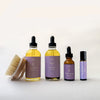Skin signs of liver damage

Our skin is a vital organ that can tell us a lot about our health.
Changes in skin color or the appearance of spots can be clear indicators of liver damage and disease , even if there are no other accompanying symptoms.
Why is our liver important and what are its functions?
The liver is a crucial organ which performs a variety of extremely important functions that help us stay healthy. Here are some of the functions of our liver:
- Detoxifying : the liver filters and removes toxins from our blood, helping cleanse our body.
- Producing bile: bile aids in digestion and absorption of fats.
- Storing nutrients : it stores essential vitamins, minerals and sugars, and releases them when our body needs them.
- Metabolizing : it plays a role in metabolizing nutrients, including carbohydrate, fats and proteins, to provide energy for our body.
- Regulates blood sugar: it helps maintain stable blood sugar by storing excess glucose as glycogen and releasing it when required.
- Supporting immune system: it plays a crucial role in immune function, helping to fight infections and diseases… etc.
Signs of liver damage on your skin
When our liver undergoes damage or dysfunction, it often manifests itself in various ways, including visible signs on our skin. Here are some of the skin signs of liver damage:
Jaundice
Jaundice is one of the most recognizable skin signs of liver damage. This condition causes skin and the white of your eyes to appear yellow. Symptoms of jaundice usually appear in your eyes and face before spreading to the rest of the body.
Jaundice occurs when the liver fails to process bilirubin, a yellow pigment produced during the breakdown of red blood cells. If the liver isn't working as it should , too much bilirubin builds up and gives a yellow appearance on your skin.
Spider Angiomas
Spider Angiomas, also known as spider nevi or spider veins, are a collection of dilated blood vessels, they are reddish and can slightly be raised.
One reason why this is thought to happen is that spider angiomas occur in response to high levels of estrogen, due to the liver not being able to metabolize hormones effectively.
Spider Veins mostly appear on the face, neck, upper chest and arms.
Palmar Erythema
Palmar Erythema is a condition where the palms of the hands turn red . it causes a general reddish color , especially in the lower areas of the palm . this skin manifestation is associated with liver diseases like cirrhosis, hepatitis, and other liver problems. Increased estrogen levels and changes in blood flow are believed to be factors contributing to this condition.
Palmar erythema is generally not painful but, in some cases it may, throb and feel tingly.
Itchy Skin (Pruritus)
Severe itchy skin can be a distress symptom associated with liver damage. Pruritus can occur due to build up of bile salts, and it's being deposited in the dermis instead of being removed by the liver. The accumulation of these bile salts in the bloodstream can cause skin irritation and extreme itching.
It usually affects the limbs, palms of the hand and soles of the feet, but it can also be generalized. Typically this skin condition gets worse in the evening, contact with excessive heat or some fabric makes it worse like wool .
Easy bruising and Petechiae
Liver dysfunction can affect the production of blood clotting factors, leading to a tendency for easy bruising or the development of petechiae. Petechiae are tiny, reddish-purple spots that appear due to capillary bleeding beneath the skin. When the liver fails to produce adequate clotting factors, blood vessels become fragile , resulting in these visible skin signs.
How can we help?
We spend a lot of time with the liver as its one of your body's most important detoxifying organs. We have created a 7 Day Liver Detox that you can find here or you can also explore our Magnesium Therapy Collection.
Why is magnesium absolutely necessary for optimal liver function?
Firstly, magnesium deficiency has been linked to an increased risk of liver disease - by adding magnesium into your skin routine and diet you are:
- Reducing inflammation: Magnesium has anti-inflammatory properties and may help reduce inflammation in the liver. Inflammation is a major contributor to liver damage and disease, so reducing inflammation may help protect the liver.
- Supporting detoxification: The liver is responsible for detoxifying the body, and magnesium is important for several of the liver's detoxification processes. Magnesium is required for the production of glutathione, a powerful antioxidant that is essential for liver detoxification.
- Regulating blood sugar: Magnesium plays a role in regulating blood sugar levels, which is important for liver health. High blood sugar levels can lead to fatty liver disease and other liver disorders.
- Preventing liver damage: Magnesium has been shown to have protective effects on liver cells and may help prevent liver damage caused by alcohol, toxins, and other factors.
You can also take magnesium in supplement form. When you take a magnesium supplement, it dissolves in your stomach and is absorbed into your bloodstream through the small intestine.
Lastly, you can apply a topical form of magnesium. You can get this in our Allure Infusion serum where we not only use magnesium chloride (mg oil) but evening primrose, golden jojoba, frankincense essential oil and YlangYlang essential oil. This is a phenomenal treatment for both your skin and your body. The magnesium in the oil itself is absorbed through the skin and into the bloodstream, where it can be transported throughout the body to be used by the cells.
The absorption of magnesium through the skin is known as transdermal absorption, and it is believed to be an effective way to increase magnesium levels in the body. When magnesium oil is applied to the skin, the magnesium ions in the oil penetrate the skin and enter the underlying tissue and bloodstream.
The speed and efficiency of absorption can depend on a variety of factors, including the quality and concentration of the magnesium oil, the location of application, and the individual's skin type and overall health. Generally, the magnesium in the oil is absorbed within a few minutes after application, but it can take up to an hour for the full effects to be felt.
Tap HERE for our Magnesium Infusion Serum
Or HERE for our complete Magnesium Therapy Collection
Check out a few of our Amazon Favorites Below












































